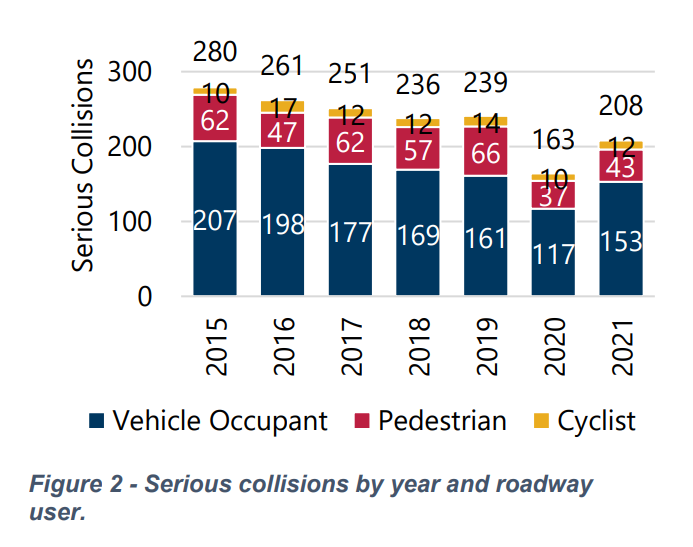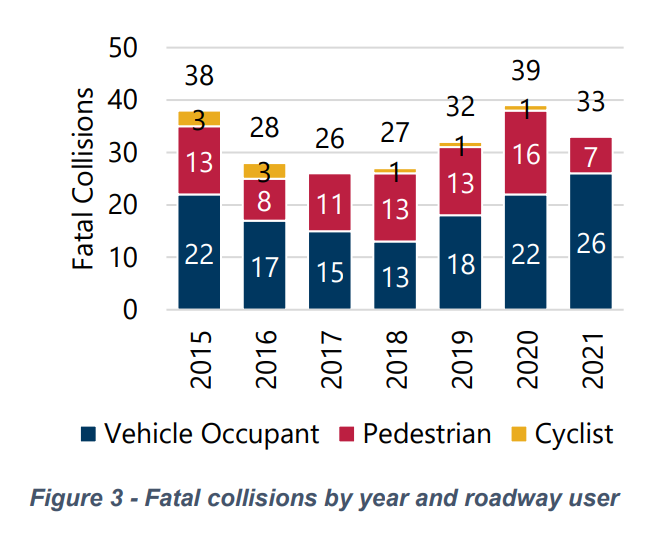By Adam Pagnucco.
Yesterday, I wrote about how a large majority of the winning county candidates favor removing police from all or some traffic enforcement. But here is a problem that must be confronted: if police are prevented from enforcing traffic laws, what happens to pedestrian and bicyclist safety?
Roadway safety is an eternal issue across the region. My difficulty in crossing the Georgia Avenue-Forest Glen Road intersection was the reason why I initially got involved in state and county politics. The county’s current effort to protect roadway users is an interdisciplinary program called Vision Zero dating back to 2016. The county’s explicit goal is to have zero deaths – hence the program’s name.
According to the county’s 2022 Vision Zero report, the county may have made some progress on pedestrian and bicycle accidents but it is not yet at zero. The charts below show serious and fatal collisions by roadway user type. Serious collisions were falling prior to the pandemic but the trend in fatal collisions is less clear.


The county’s 2030 action plan is a 98-page document embracing a holistic approach to traffic safety. Its main elements are complete and safe street design, modifying speed limits, improved outreach (especially to communities of color), curbing drunk driving, improving safety of the county’s own vehicle fleet and prioritizing rapid emergency response. Police traffic enforcement is a key tool and the plan mentions it over and over again. Examples include:
“Enforcement and education remain a critical aspect of the safe system but work as compliments to safe street design.” Page 22
“Under Vision Zero, modifications to the posted and design roadway speeds will create self-enforcing roads where drivers operate safely. Where speed compliance remains a public safety issue, police will utilize officer and automated enforcement.” Page 30
“The County will utilize outreach and enforcement efforts to explain the dangers of speeding and enforce the speed limit.” Page 43
“Enforcement of Speed Limits: Utilize hybrid (automated and officer initiated) approach for keeping drivers of motor vehicles at or below the speed limit.” Page 44
“High Visibility Enforcement is a proven countermeasure and universal traffic-safety approach designed to create deterrence and change unlawful and risky driving behaviors.” Page 44
“Culture of Safety actions are intended to improve two-way communication between the County Government and communities most impacted by serious traffic crashes, empower communities to speak up for safety, and vigilant use of officer and automated enforcement.” Page 59
“Promote and increase number of joint operations with municipal and State Police as part of high visibility enforcement campaigns focused on interstates and major arterials.” Page 61
“Expand driving under the influence of drugs (DUID) and advanced roadside impaired driving enforcement (ARIDE) training for all MCPD cadets at the academy.” Page 61
“Focused Enforcement Efforts: Focus the efforts of MCPD officers on curbing the most dangerous behaviors (occupant protection, speeding and aggressive driving, not yielding right of way, impairment from alcohol or drugs, and distraction) and less on nonmoving violations.” Page 62
The plan also links to this 2004 study of a police traffic enforcement program in Miami Beach. The study’s summary stated:
A driver-yielding enforcement program that included decoy pedestrians, feedback flyers, written and verbal warnings, and saturation enforcement for a 2-week period was evaluated in the city of Miami Beach using a multiple baseline design. During baseline, data were collected at crosswalks along two major corridors. Treatment was introduced first at selected crosswalks without traffic signals along one corridor. A week later, enforcement was shifted to crosswalks along the second corridor. Results indicated that the percentage of drivers yielding to pedestrians increased following the introduction of the enforcement program in each corridor and that these increases were sustained for a period of a year with minimal additional enforcement. The effects also generalized somewhat to untreated crosswalks in both corridors, as well as to crosswalks with traffic signals.
But not everyone agrees with police traffic enforcement.
The county’s Reimagining Public Safety Task Force wrote that, “The county should move to fully (or expanded) automated traffic enforcement through expansion of speed and intersection camera programs, and reduce FTE sworn officer positions across MCPD districts in proportion to the amount of officer time currently spent on in-person traffic enforcement by sworn officers.”
The county council’s Policing Advisory Commission has stated that it “believes that traffic enforcement practices in the County do not meet basic tests of effectiveness, efficiency, and equal enforcement, and that a change in mission, focus, and strategy is necessary.”
So the county’s politicians and appointees are saying one thing and its own traffic safety experts are saying something very different. What path will the county take?
